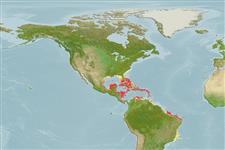>
Ophidiiformes (Cusk eels) >
Ophidiidae (Cusk-eels) > Ophidiinae
Etymology: Parophidion: Greek, para in the side of + Greek, ophidion, diminitive of ophis = serpent (Ref. 45335).
Eponymy: Karl Patterson Schmidt (1890–1957) was a herpetologist. [...] (Ref. 128868), visit book page.
Environment: milieu / climate zone / depth range / distribution range
Sinh thái học
Biển gần đáy. Subtropical
Western Atlantic: Bermuda, Bahamas and southern Florida (USA) to northern South America.
Bộ gần gũi / Khối lượng (Trọng lượng) / Age
Maturity: Lm ? range ? - ? cm
Max length : 10.0 cm TL con đực/không giới tính; (Ref. 7251)
Short description
Khóa để định loại | Hình thái học | Sinh trắc học
Scales on body in anguilloid pattern, somewhat overlapping, interorbital region scaled, opercle naked, cheeks, top of head forward to centre of interorbital region scaled; ethmoid spine reduced to a low bump; gill chamber and guts pale; no pyloric caeca; males with posterior opening on swim bladder; the two pelvic fin rays equally long or very nearly so (Ref. 34024).
Uncommon species (Ref. 34024). Adults occur in shallow coastal waters, usually in turtle grass beds (Ref. 7251). Oviparous, with oval pelagic eggs floating in a gelatinous mass (Ref. 205).
Life cycle and mating behavior
Chín muồi sinh dục | Sự tái sinh sản | Đẻ trứng | Các trứng | Sự sinh sản | Ấu trùng
Nielsen, J.G., D.M. Cohen, D.F. Markle and C.R. Robins, 1999. Ophidiiform fishes of the world (Order Ophidiiformes). An annotated and illustrated catalogue of pearlfishes, cusk-eels, brotulas and other ophidiiform fishes known to date. FAO Fish. Synop. 125(18):178p. Rome: FAO. (Ref. 34024)
IUCN Red List Status (Ref. 130435: Version 2024-1)
Threat to humans
Harmless
Human uses
Các nghề cá: không ích lợi (thú vị)
Các công cụ
Can't connect to MySQL database fbquizv2. Errorcode: Too many connections
